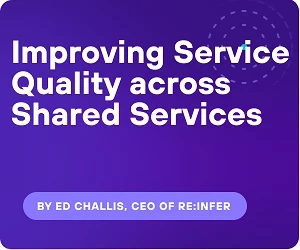Shared Services Improvement: The Road to Communications Mining
Add bookmark
Shared services leaders are under continuous pressure to drive efficiency, reduce waste and meet their targets. In most cases, they retain ultimate responsibility for the efficiency of their function. The widespread adoption of Process Mining, therefore, could not have come too soon.
Analysing event logs and data, Process Mining lets shared services teams sidestep the time-consuming task of process mapping. Instead, they automatically see where inefficiency exists in the service function.
In the last decade, Process Mining has transformed how shared services improvement is done. Yet it only tells one half of the story and serves as a stepping stone to even greater efficiency. Process Mining shows you ‘how’ a process happened and where it could have broken down. But it doesn’t explain ‘why’.
Businesses tend to have plenty of tools that explain the ‘what’ and ‘how’ of their processes. But they so often lack the means to recognise ‘why’ - and you can’t build a truly efficient shared services function until you understand the demand that drives it. To understand that demand, it’s crucial you make sense of your organisation’s unstructured conversational data.
Unstructured conversational data - such as emails, tickets, instant messages, and notes in ERP systems - represents a growing but largely untapped source of valuable insight into root causes. Up to 90% of business data is thought to be unstructured - much of it from communications channels. It could be a customer requesting an update, or an employee flagging a systems issue. The trouble is that these events are expressed in natural, conversational language - something traditional Process Mining struggles to understand.
To make sense of this unstructured conversational data, Communications Mining is essential.
Process Efficiency: Explaining the ‘why’
Communications Mining is an even more recent development in process intelligence than Process Mining. Yet, its potential goes well beyond simple process improvement.
Communications Mining is an increasingly popular class of enterprise software that extracts value from unstructured conversational data - from emails to telephone conversations. It uses natural language processing (NLP) and machine learning to understand business conversations at scale and converts them into structured data that can then be actioned by key stakeholders. Communications are analysed in real-time, giving service leaders full visibility into the work of their agents.
Communications Mining can be deployed anywhere in a service function where comms channels are embedded in core processes. It pulls the most valuable information from the conversations of agents, colleagues and customers. It could, for example, reveal the most common causes of service requests or highlight the manual, repetitive processes that waste your agents’ time.
In this way, Communications Mining is key to understanding a complete, end-to-end user or customer journey. Structured data will give you a detailed picture of how a process is performing, but you need to analyse unstructured conversational data to understand how the user is interacting with it and other connected processes. The focus is on the person, not the process. The demand rather than the path taken.
The real advantage of Communications Mining is that it enables service leaders to measure the counterfactual. When looking at service interactions, this isn’t about understanding what has happened in a particular process - it’s about discovering what could have happened and what the user wanted to happen. What need did a customer express, and why didn’t they receive it? This insight into the ‘why’ rather than the ‘what’ or ‘how’ is only available through Communications Mining.
Process Mining drives efficiency gains - and for that reason it’s an essential tool for shared services. However, processes often fail not because they aren't efficient, but because they simply don’t meet the demands of the customer. Services that don’t deliver what users want or expect. Making a redundant process more efficient won’t achieve much for an organisation. Instead, a business has to understand how a process should change to deliver better outcomes for employees and customers.
Process Mining creates better processes. Communications Mining enables you to build your processes around the customer.
Process Mining and Communications mining: A Perfect Match
There’s no panacea for a superior, efficient shared services centre. Even Communications Mining, while powerful, is only a part of the technology stack needed to improve a service function. Indeed, it creates the most value when working with complementary Process Mining and automation solutions.
Communications Mining is the first step along the road. It identifies points of friction in services data, flagging relevant areas for deeper analysis by Process Mining tools. If these are shown to be causing inefficiency, the organisation can then consider ways of streamlining them. The fact that Communications Mining already converts unstructured conversations into structured data creates many new opportunities for automating transactional tasks, tickets and service requests.
A service function can’t improve its processes without first understanding its customers - internal and external. Similarly, improving the back end won’t necessarily enhance front-end experiences. There needs to be an understanding of what’s going on and why. The role of Communications Mining is to act as a guide, helping businesses find the best locations to mine for gold.
Greater efficiency is only one outcome. Once a service leader knows where their challenges lie, it has the insight it needs to transform their operation for good. Shorter handling times, happier customers, reduced churn and more positive service outcomes – these are the fruits of Communications Mining.
















